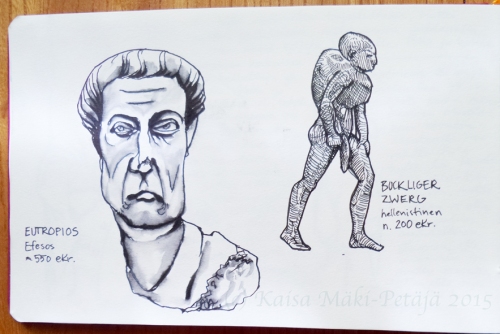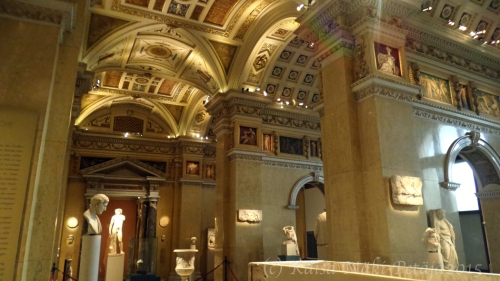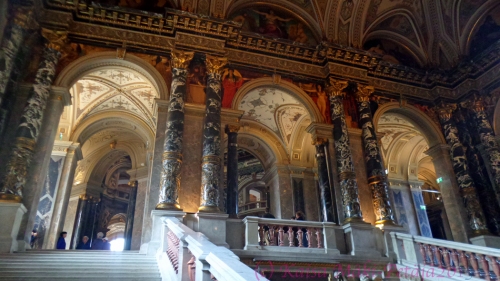While in Vienna for an archeological conference last November, I sneaked away for a visit in the Kunsthistoriches Museum, the Art Historical Museum. I entered soon after it had opened for the day and exited 7 hours later – and I hadn’t seen even the half of it.
The museum seems to have everything from the Ancient Rome and Greece to the modern and the contemporary, from polished gems to huge canvases. If you go through the museum following the chronological order from the oldest to the latest, the first parts are more like a curiosity cabinet and that makes it even more fascinating. It is easy to imagine that you are visiting the private collections of the emperor seeing his favourite curiosities – which most of the artifacts and works of art originally were. The splendour, the sumptuousness, the sheer extravagance is breathtaking. For example, take a look at this vase:

Looks like crystal, doesn’t it, but it’s not. It is actually made of a single quartz crystal, a rock crystal, not glass. It big, huge, actually: maybe 50cm from the base to the top. And it was not the only one. If you look carefully, you can see two others behind it, and that’s not all of them. There are dozens of various sizes on display!
It’s difficult to comprehend the amount of wealth that made collecting on this scale possible.
Another impressive piece of craftsmanship were these structurally realistic and extremely detailed, delicate bouquets made of various metals. The patience it must take to create one of these:

Nice, but I wouldn’t want to dust these. Suppose that’s why one would have an army of servants…
There were so many amazing works of art that I just walked from one to the next in complete awe. It wasn’t until I got to the Roman and Greek collections that I managed to draw something. The Classical statues and other artifacts were more familiar and they therefore did not left me as wonderstruck as the other curiosities. This classical athlete/prince was one of my favourites:

The bronzes and other statues were extremely well lit, as you can see. The light levels were rather low (it’s not necessary for the conservation) and spotlights highlighted the statues beautifully. (Hihii!) But seriously, an even, monotonous lighting is not the best for three dimensional works of art. A more subdued and directional light reveals the character of the statues. Also, the museum had succeeded in avoiding one of the most annoying mishaps of museum lighting: the head of the visitor shading the object. You might have noticed this in most museums. Often the spotlights are placed so that when you get closer to a vitrine to have a closer look as something, your head and shoulders get in front of the light and you unavoidably cast a shadow on the object. No matter how you try to move, the object remains in shadow unless you move back and you again can’t see the detail you were interested in. Here this was seldom a problem. All the artifacts in these pictures were in vitrines but, as you can see, there are only a few reflections from the glass.

The was my favourite one. It’s not a Classical but a Neoclassical sculpture. Sadly I have lost the piece of paper on which I wrote the artist’s name.
There ware so many incredible artifacts there that it would have been easy to become lost in photographing everything I saw. I did manage to fight the urge and drew these two treasures:

I bet Eutropios lit up the room when he walked in.
The one on the left was a bust of a really sour looking fella. Not your standard Classical head. Delightful! The one on the right was a small, maybe 6-7cm tall bronze figurine, a kind of an idol. Sadly there was very little information available in English in the exhibition. I really would like to know more about these disfigured idols.

It wasn’t only the objects of art that were impressive, the museum building itself is magnificent. This, of course, should not be surprising. What else could an originally imperial art museum be! However, the trouble with imperial splendour is that it sometimes overwhelms the art, like here in the hall of classical marbles where the sculptures were lost in the marble walls and gilded ceilings. Sometimes you just can’t tell the trees from the forest (not the other way round).
The marbles hall aside, the building is an art historical wonder in itself. You could spend a day looking at it alone, drinking in all the architectural details, period features, and intertextual clues and icons. Sitting in the upper restaurant was in itself a superb experience. And the lunch wasn’t too bad either.

Now this is a proper staircase.
It was a wonderful seven hours but while it uplifted me, it was also slightly exhausting. In a way is was a delight to return to the conference the next morning and to spend most of the day listening to various presentations. Not that they were dreary but they are less exiting in an electrifying kind of a way. More subdued and intellectually inspiring in other ways. Though I would love to be there when a scientific presentation gets the audience to jump up in excitement…

Aug 06, 2016 @ 22:04:48
Can we acquire one of those neoclassical sculptures too? Please? Pretty please? It would looke nice in our “library”… 😉
Aug 06, 2016 @ 22:11:01
Sure thing, hubby. The first thing we’ll do when hit the jack pot in the lottery. 😀